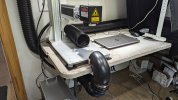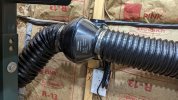Stacy E. Apelt - Bladesmith
ilmarinen - MODERATOR
Moderator
Knifemaker / Craftsman / Service Provider
- Joined
- Aug 20, 2004
- Messages
- 38,265
Venting outside is by far the best choice.
My new setup brings in outside air (six-inch powered duct blower) and exhausts the fine grinder dust outside into a catch barrel. There is surprisingly little in the outside barrel, as the heavy stuff gets trapped in the spark collector/cyclone. Because I live in a fairly moderate temperature climate, I don't need to worry about the air temp from outside.
I use a dedicated grinder for wood which has a separate cyclone collector, and then gets vented into the same outside barrel.
A HEPA hanging filter to filter the free air in the shop is also a wise choice. Mine comes on when I turn the lights on in the grinding room.
An important thing to remember is that no filter will do any good if you don't regularly clean it out and change the filters. A regimented schedule of PM written on the shop calendar is a good idea. Dump the buckets, vacuum the fitters, put in new consumable filters, etc. once a month or on whatever schedule your shop needs.
One thing that needs to be considered for any air system that exhausts the air outside is AIR EXCHANGE. Whether it be a window fan, a dust collector, or a whole shop vent system, there needs to be an equal or greater amount of incoming air or you will have negative air pressure. Depending on the amount or exhausted airflow, it can be an open door or window, or a forced air vent bringing in fresh air.
My new setup brings in outside air (six-inch powered duct blower) and exhausts the fine grinder dust outside into a catch barrel. There is surprisingly little in the outside barrel, as the heavy stuff gets trapped in the spark collector/cyclone. Because I live in a fairly moderate temperature climate, I don't need to worry about the air temp from outside.
I use a dedicated grinder for wood which has a separate cyclone collector, and then gets vented into the same outside barrel.
A HEPA hanging filter to filter the free air in the shop is also a wise choice. Mine comes on when I turn the lights on in the grinding room.
An important thing to remember is that no filter will do any good if you don't regularly clean it out and change the filters. A regimented schedule of PM written on the shop calendar is a good idea. Dump the buckets, vacuum the fitters, put in new consumable filters, etc. once a month or on whatever schedule your shop needs.
One thing that needs to be considered for any air system that exhausts the air outside is AIR EXCHANGE. Whether it be a window fan, a dust collector, or a whole shop vent system, there needs to be an equal or greater amount of incoming air or you will have negative air pressure. Depending on the amount or exhausted airflow, it can be an open door or window, or a forced air vent bringing in fresh air.








